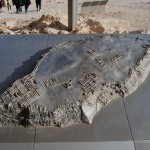Masada Fortress (Israel)
Masada (מְצָדָה, Metzada) is a fortress at the southern tip of the Dead Sea (25 kilometers south of Ein Gedi) on top of a mountain (around 450 meters), rebuilt by Herod the Great between 37 and 31 B. C., which later became the last refuge of zealots during their anti-Roman insurgence of 66-73 A. D.
According to Josephus Flavius, Masada was first fortified by High Priest Jonathan but it remains unclear whether it was Jonathan Hasmonean, Judas Maccabee’s brother (middle of II century B. C.) or Alexander Yannai (103-76 B. C.) who was also named Jonathan. In 40 B. C., when Parthians brought Antigonus II to the Judea’s throne, Herod fled from Jerusalem to Masada; then, after he left his family and his brother Joseph under the protection of 800 soldiers, he left for Rome. Antigonus besieged Masada but its defenders who suffered because of lack of water were saved by a sudden rain that filled holes and clefts with water. In 37 B. C., after he was enthroned in Judea, Herod turned Masada into a mighty fortress, which could serve as a refuge place in case of an insurgence or an invasion of the Egyptian queen Cleopatra.
In 6-66 A. D., in Masada, most likely, a Roman garrison was located. In 66, with the beginning of the Jewish war, Menahem, son of Judah from Galilee, heading a group of zealots captured Masada. After Menaham’s assassination in a public strife in Jerusalem, Eleazar ben Ya’ir, Menahem’s nephew, escaped to Masada where he headed up a Jewish garrison until the fortress fell in 73. During the rebellion the fortress served as a refuge to all those, who feared to be captured by Romans. In 72, Masada was the only island of rebellion in the country and Flavius Sylva besieged the fortress with the Tenth Legion (traces of 8 camps were found). The Romans raised a bank around 70 meters high upon which a battering-ram was moved. When after a long siege they were able to make a breach in the fortress wall, Eleazar convinced the defenders to commit suicide to escape the hands of Romans; Josephus Flavius, referring to the account of two women, who survived with five children in a cave, portrays the last hours of the fortress’ defenders: men killed their wives and children and then, by lot, — killed each other. The last one of the 960 besieged, set the fortress on fire and killed himself. After Masada fell, a Roman garrison was stationed there (until 111).
Masada was first identified by A. Robinson in 1838. In 1842, American missionary S. U. Walcott and British artist Tipping visited Masada. In 1851, L. F. deSolsi made the first fortress layout. In 1867, C. Warren visited this place; in 1875 — K. R. Conder made a map of Masada. In 1909, A. V. Domashevsky and R. E. Bryunnov carried out a detailed research of the ruins of Roman camps near the fortress. In 1932, A. Shulten supervised excavations of Masada. In 1953, Israeli archeologists S. Gutman and A. Allon researched the water supply system and carried out excavations of one of the Roman camps. Excavations in 1955 and 1956 allowed to define the outline of the fortifications and make a map of the Citadel. Major excavations were carried out in Masada in 1963-1965 by I. Yadin who headed up a big archeological expedition (hundreds of volunteers from the whole world). In the course of excavations almost the entire built-up territory of the rock was cleared from dirt and ancient buildings were partially restored. Excavations, by the way, exposed the remnants of a settlement of the Chalcholithic period (4,000 B. C.) as well as water collectors of pre-Herodian period; numerous coins of Alexander Yannai allow us to come to the conclusion that these water collectors date back to the Hasmonean period.
The fortress of Herodian period, which occupied the entire space of the flat diamond-shaped plateau (around 650X250 m), was surrounded by a double wall (around 1,400 m in perimeter), the inner territory of which was divided into casemates (over 70). There were 30 towers in the wall and four gates shaped as square rooms with two entrances, paved floor and seats along the walls, adorned with frescoes. The fortress was supplied with water through open plastered channels for rainwater that flowed from two canyons west of Masada into 12 water-collecting cisterns hewn out in two parallel rows in the north-western slope of the mountain (total capacity — around 40,000 m3). The water was carried manually from here to other cisterns on top of the mountain, mostly under the ground.

